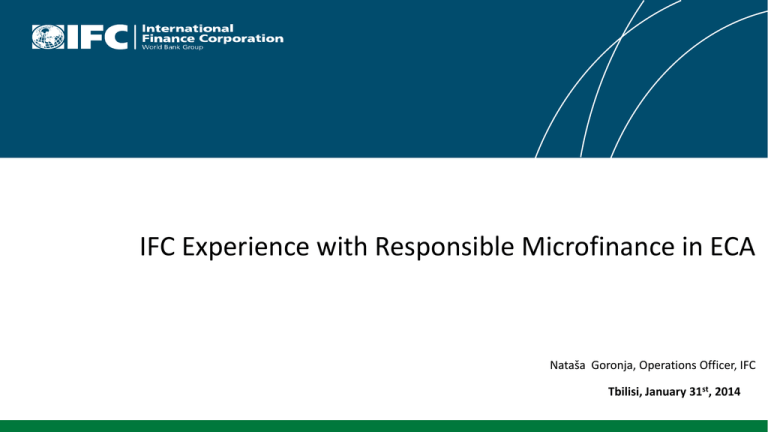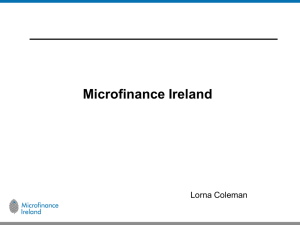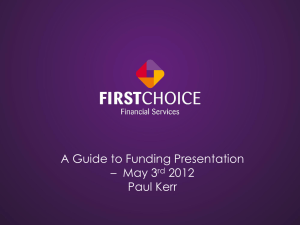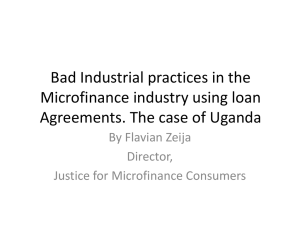Risk Segmentation
advertisement

IFC Experience with Responsible Microfinance in ECA Nataša Goronja, Operations Officer, IFC Tbilisi, January 31st, 2014 Agenda 1. Bosnia as an over-indebtedness cautionary tale, but on the mend now 2. How we learned to measure market level over-indebtedness and annual survey results 3. Partnering with SMART to raise the responsible finance standards in mf through self-regulation 2 Bosnia as a cautionary tale • Microfinance started post-war, late 90’s • Quickly grew and considered a success case by early 2000’s • In 2008, $800 million annual MIV investment received into the sector • In 2008, 28 alleged client suicides • By 2012, 40% industry level equity loss • 3 What do we mean by mean by over-indebtedness? by Over-indebtedness? • Refers to the risk faced by credit customers of taking on levels of debt that may be greater than they can manage, or that cause undue sacrifices to repay • Can result from a range of causes, including personal errors in estimating levels of manageable debt, changes in income, unforeseen circumstances • Six over-indebtedness proxies: negative impact, default and arrears, debt ratios, multiple borrowing, borrower struggle and sacrifice, and composite indicators from CGAP IFC Credit Reporting at the Base of the Pyramid How do we establish the risk matrix? Two dimensions: • Essential and utility expenditure as a % of income (objective) and • Risk vulnerability (subjective) dimension S u b j e c t i v e Objective (loan repayment to income) Risk Vulnerability Questions Used Result: Risk Segmentation of BiH Debtors - 2011 Vulnerability and Affordability High Debtor Concern and Inability to meet Financial Commitments = Weighted Vulnerability Score Low Essential Expenditure & Utilities as % Income High 2013 Risk Matrix : 3,000 people have different views of their financial position Different risk and service propositions – not a simple financial formula High Exposed Debtor Concern and Inability to meet Financial Commitments = Weighted Vulnerability Score Low Affordable Vulnerable Concerned Essential Expenditure & Utilities as % Income High Three years of data - Is risk exposure beginning to polarise ? High 21 – 25 Debtor Concern and Inability to meet Financial Commitments = Weighted Vulnerability Score Low 29 – 28 - 24 % 31 % 23 – 21 - 24 % 27 – 26 - 22 % Essential Expenditure % Income High What outlook for the risk portfolios ? Affordable Concerned Vulnerable Vulnerable Distribution 31 % 24 % 22 % 24 % Net Disposable Income (pre loan) KM 1,480 KM 1,220 KM 530 KM 235 Average Loan KM 5,600 KM 6,300 KM 4,800 KM 4,400 Loan Repayment % of Net Income 16 % 21 % 47 % 99 % Loan Arrears 0% 13 % 2% 24 % Other Impact of Debt Loan Arrears : 2013 9 % : 2012 9 % : 2011 9% Utility Arrears : 2013 12 % 2012 19 % : 2011 21% Awareness of Financial Strains : 23 % Remainder : 2013 22 % 2012 20 % : 2011 22% The Risk Dynamics of Different Markets : What Local Actions and Response? © International Finance Corporation Roy Pratt – December 2013 Why are cities so different … ? © International Finance Corporation Roy Pratt – December 2013 Partnership with SMART, Deutsche Bank, and others January 2013 www.smartcampaign.org www.smartcampaign.org Vision of the Smart Campaign The Smart Campaign envisions a fundamental transformation of the microfinance industry in four key ways: Focus on clients • All industry stakeholders will put the interests of clients first Transparent and prudent services Full integration of client protection • MFIs will provide transparent, respectful, prudent financial services • Client protection principles will be fully integrated into all microfinance operations 17 Gain pro-consumer reputation • The microfinance industry will be distinguished as leader in responsible finance Certification Overview Client Protection Certification is an independent, third-party evaluation to publicly recognize institutions that meet adequate standards of care in client protection. The Certification program was launched in 2013 to set global standards around client protection in the microfinance industry. The program is designed for retail financial institutions that provide services to financially excluded or underserved populations. 18 Certification Standards 7 Principles 30 Standards 95 Indicators 19 Epilogue: Some signs of improved budget control and realism in Bosnia … different clients – different needs ? © International Finance Corporation ? ? Roy Pratt – December 2013 Thank you! Risk Segmentation : The Impact of Savers … A Different Risk Segment 14% 31% 36% 19% Ratio Household Income KM Net Disposable Income (after loan) Loan KM Loan Arrears Utility Arrears MFI : Savers 27 % 1,950 KM 885 3,730 5% 6% MFI : Non-Savers 73 % 1,500 KM 550 3,420 10 % 20 % Bank : Savers 38 % 2,200 KM 950 7,210 2% 4% Bank : Non-Savers 62 % 1,570 KM 560 7,430 15 % 28 % © International Finance Corporation Roy Pratt – December 2013 Risk Segmentation … What is the proposition ? Net Disposable Income (after loan Loan KM Loan Arrears Utility Arrears Change of Lenders Ratio Household Income KM MFI : Single 80 % 1,645 KM 710 2,750 6% 14 % MFI : Multiple 20 % 1,575 KM 415 6,650 17 % 24 % Bank : Single 81 % 1,770 KM 735 6,900 9% 17 % Bank : Multiple 19 % 1,945 KM 620 6,800 17 % 28 % Up to 6 months 36 % 1,450 KM 530 4,400 11 % 25 % 7 – 12 months 27 % 1,730 KM 700 5,100 9% 15 % Over 12 months 37 % 1,920 KM 810 6,300 7% 11% Time since last loan approval © International Finance Corporation Roy Pratt – December 2013 Risk Segmentation … The Challenge of Low Household Income 12% 14% 26% © International Finance Corporation 24% 24% Roy Pratt – December 2013 Income Segmentation : Budget Pressures on Income Groups up to KM 1,500 Average © International Finance Corporation 45% 52% 60% 76% 90% Roy Pratt – December 2013 Responsiveness improves again … but still further to go … and some core problems © International Finance Corporation Roy Pratt – December 2013 Outlook for Lending … Risk sensitivity to the Saver Segment … What will they do ? 25% 34% 33% 3% 4% Loan Loan Arrears Arrears Utility Utility Arrears Loan Loan :: Family Family Food Food Expenditure Expenditure Reduced Reduced Loan Loan within within 66 months months 11 11 % % 25 25 % % 12 12 % % 22 22 % % 18 18 % % 33 33 % % 19 19 % % Need Need to to borrow borrow :: MFI MFI 10 10 % % 10 10 % % 12 12 % % 21 21 % % 31 31 % % 42 42 % % 30 30 % % Need Need to to borrow borrow :: Bank Bank 13 13 % % 23 23 % % 11 11 % % 13 13 % % 32 32 % % 40 40 % % 32 32 % % Other Other borrower borrower No Savings No Savings 12 12 % % 20 20 % % 12 12 % % 27 27 % % 22 22 % % 32 32 % % 20 20 % % Other Other Borrower Borrower Savings Savings 3% 4% 3% 5% 12 % 16 % 11 % © International Finance Corporation More More than than 11 Additional Additional loan loan in in last last 33 Employment Employment years years More More than1 than1 lender lender in in last 3 years last 3 years Roy Pratt – December 2013 Own Business : Bank Borrowers Strengthen 2012 2013 MFI : KM 2,200 KM 2,050 Bank : KM 2,900 KM 2,500 © International Finance Corporation 2012 2013 MFI : KM 8,850 KM 7,050 Bank : KM 18,250 KM 9,400 Roy Pratt – December 2013 Surveys 2013 : A delicately balanced situation … for borrowers and lenders LOWEST INCOME HOUSEHOLDS : Continued tightening Impact on portfolio quality – debt dependency - lender support – additional debts DIFFERENT BORROWER SEGMENTS : Different risks need different products and services Low income – location – ‘savers’ / ‘non-savers’ – recent loan approvals – bank / MFI client movement PROBLEM DEBT MANAGEMENT : Improved response to some borrowers and majority still want assistance Lending institutions provide loans … but … many clients have minimal capacity to break from the ‘debt-trap’ LENDING STRATEGY : Reduced loan size and more stable employment Changing structure of lending portfolios … incremental credit quality … performance of different segments STRATEGIC RISK : Outlook for Loan Portfolios of Banks and MFIs Structural risk profile – sensitivity to income and cost changes – business case of borrower segments © International Finance Corporation Roy Pratt – December 2013 Key Issues to Address Strategic Outlook for Borrowing Institutional Reputation Operational Credit Quality of Incremental or Marginal Lending Financial Counselling © International Finance Corporation Roy Pratt – December 2013









